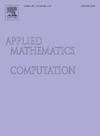Learning influence probabilities in diffusion networks without timestamps
IF 3.5
2区 数学
Q1 MATHEMATICS, APPLIED
引用次数: 0
Abstract
Inferring information diffusion networks plays a crucial role in social network analysis and various applications. Existing methods often rely on the infection times of nodes in diffusion processes to uncover influence relationships. However, accurately monitoring real-time temporal information is challenging and resource-intensive. Additionally, some approaches that do not utilize infection timestamps fail to adequately capture the strength of influence relationships among nodes. To address these limitations, we propose a novel method called Learning Influence Probabilities in diffusion Networks without timestamps (LIPN). LIPN introduces an enhanced correlation metric to measure the relationship between node infections, which is utilized in the pre-pruning stage to mitigate the negative impact of redundant candidate edges during the inference process. LIPN constructs a likelihood function for the diffusion process by considering the infection probability between nodes. Furthermore, to enhance the reliability of the inferred results, LIPN incorporates an optimization strategy that combines an expectation maximization algorithm with a variant of the simulated annealing algorithm. The experimental results validate the effectiveness of LIPN in both synthetic networks and real-world networks, highlighting its potential for empowering social network analysis and applications.
无时间戳扩散网络影响概率的学习
信息扩散网络的推断在社会网络分析和各种应用中起着至关重要的作用。现有的方法往往依赖于扩散过程中节点的感染次数来揭示影响关系。然而,准确监测实时时间信息是具有挑战性和资源密集型的。此外,一些不利用感染时间戳的方法无法充分捕捉节点之间影响关系的强度。为了解决这些限制,我们提出了一种新的方法,称为无时间戳扩散网络中的学习影响概率(LIPN)。LIPN引入了一个增强的相关度量来衡量节点感染之间的关系,该度量在预剪枝阶段被用来减轻冗余候选边在推理过程中的负面影响。LIPN通过考虑节点间的感染概率,构造了扩散过程的似然函数。此外,为了提高推断结果的可靠性,LIPN采用了一种优化策略,该策略将期望最大化算法与模拟退火算法的变体相结合。实验结果验证了LIPN在合成网络和现实世界网络中的有效性,突出了其在增强社会网络分析和应用方面的潜力。
本文章由计算机程序翻译,如有差异,请以英文原文为准。
求助全文
约1分钟内获得全文
求助全文
来源期刊
CiteScore
7.90
自引率
10.00%
发文量
755
审稿时长
36 days
期刊介绍:
Applied Mathematics and Computation addresses work at the interface between applied mathematics, numerical computation, and applications of systems – oriented ideas to the physical, biological, social, and behavioral sciences, and emphasizes papers of a computational nature focusing on new algorithms, their analysis and numerical results.
In addition to presenting research papers, Applied Mathematics and Computation publishes review articles and single–topics issues.

 求助内容:
求助内容: 应助结果提醒方式:
应助结果提醒方式:


